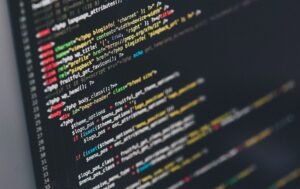Application JavaFX
JavaFX is a powerful framework for building desktop applications using Java. Whether you need a complex enterprise application or a simple user interface, JavaFX provides the tools and components you need to create stunning and responsive applications.
Key Takeaways
- JavaFX is a framework for creating desktop applications using Java.
- It provides a rich set of components and tools for building responsive and visually appealing applications.
- JavaFX supports CSS styling to customize the appearance of applications.
- It offers a scene graph model for organizing and managing graphical elements.
In JavaFX, applications are built using a combination of Java code and XML-based markup called FXML. FXML allows you to separate the structure and layout of your application from its logic, making it easier to maintain and update. **JavaFX applications are platform-independent**, meaning they can run on any operating system that supports Java.
The scene graph, which is a hierarchical structure of graphical elements, forms the backbone of JavaFX applications. Each element in the scene graph is called a node and can have properties such as position, size, and opacity. Nodes can be nested to create complex UI layouts, and they can also be styled using CSS.
JavaFX Features
JavaFX offers a wide range of features that make it a popular choice for application development:
- Rich UI components: JavaFX provides a large set of UI controls such as buttons, text fields, and tables, allowing you to create professional-looking interfaces.
- Animation and effects: With JavaFX, you can easily add animations and visual effects to your applications to make them more engaging and interactive.
- Media support: JavaFX includes built-in support for playing audio and video files, making it easy to incorporate multimedia content into your applications.
- Web integration: JavaFX allows you to embed web content within your applications, making it possible to display web pages or interact with web services.
- Internationalization: JavaFX provides support for localization, allowing you to easily translate your application into different languages.
Performance and Compatibility
JavaFX is designed to deliver high-performance user interfaces. It leverages the hardware acceleration capabilities of modern GPUs to ensure smooth rendering and animation. Additionally, JavaFX applications can take advantage of multi-threading to keep the UI responsive even when performing computationally intensive tasks.
| Operating System | JavaFX Support |
|---|---|
| Windows | Yes |
| macOS | Yes |
| Linux | Yes |
JavaFX allows developers to create visually stunning applications with ease, taking advantage of powerful features and extensive compatibility. Whether you’re a beginner or an experienced Java developer, JavaFX provides a flexible and robust platform for building desktop applications.
Getting Started with JavaFX
To start developing JavaFX applications, you need to have Java Development Kit (JDK) installed on your system. The latest version of JavaFX is included in JDK starting from version 7u6, so make sure you have the latest JDK installed.
- Install JDK: Download and install the appropriate JDK for your operating system from the Oracle website.
- Set up your development environment: Configure your development environment (e.g., IntelliJ IDEA or Eclipse) to work with JavaFX.
- Start coding: Create a new JavaFX project and begin developing your application using the JavaFX APIs and tools.
With JavaFX, you have the power to create desktop applications that are both visually appealing and highly functional. Start exploring its rich features and unleash your creativity to build amazing applications today!

Common Misconceptions
Misconception 1: JavaFX is only used for desktop applications
One common misconception about JavaFX is that it is exclusively for creating desktop applications. However, JavaFX is not limited to the desktop and can be used to create applications that run on a variety of devices such as mobile phones, tablets, and even embedded systems.
- JavaFX can be used to develop mobile applications for Android devices.
- It is possible to create web applications using JavaFX and embed them in a web page.
- JavaFX can be used to build applications for Internet of Things (IoT) devices.
Misconception 2: JavaFX is outdated and not actively maintained
Another misconception is that JavaFX is outdated and no longer actively maintained. However, this is not true as Oracle has been regularly releasing updates and bug fixes for JavaFX. Furthermore, JavaFX has a strong community of developers who continue to work on improving the framework.
- JavaFX was introduced by Oracle in 2008 and it is still actively used and supported.
- Oracle released JavaFX 16 in March 2021, demonstrating its commitment to the framework.
- JavaFX has a large and active community, providing support and updates to the framework.
Misconception 3: JavaFX is difficult to learn and use
Many people believe that JavaFX is a complex framework and that it is difficult to learn and use. However, JavaFX provides a rich set of tools and libraries that make it easier to create user interfaces and rich graphical applications.
- JavaFX provides a scene graph API that simplifies the creation and management of graphical elements.
- JavaFX has a comprehensive set of layout managers that help in arranging UI components.
- There are numerous tutorials, documentation, and online resources available to learn and understand JavaFX.
Misconception 4: JavaFX is only for Java developers
Some people wrongly assume that JavaFX can only be used by developers who are proficient in Java programming language. However, JavaFX can be utilized by developers who have knowledge of other programming languages and frameworks.
- JavaFX can be used with other JVM-based languages such as Kotlin and Scala.
- Developers familiar with HTML, CSS, and JavaScript can integrate JavaFX application into web pages.
- There are tools and libraries available that allow developers to use JavaFX with other programming languages.
Misconception 5: JavaFX is not suitable for enterprise applications
Many people mistakenly believe that JavaFX is not well-suited for building large-scale enterprise applications. However, JavaFX provides features and capabilities that make it suitable for developing robust and scalable enterprise applications.
- JavaFX offers support for advanced UI features such as 3D graphics, media playback, and animations.
- It integrates smoothly with other Java enterprise technologies like Java EE and Spring.
- JavaFX applications can be easily deployed on a variety of platforms, making it suitable for enterprise environments.

The Rise of JavaFX: A Game Changer for Application Development
JavaFX, an advanced platform for creating rich internet applications, has been gaining significant attention in recent years. This article sheds light on various aspects and benefits of JavaFX through ten captivating examples:
1. Streaming Video Playback Support
JavaFX provides seamless integration with multimedia components, allowing for smooth and high-quality streaming video playback without any latency issues. This functionality has revolutionized the way video content is consumed in the digital age.
2. Advanced Data Visualization
With JavaFX, developers can create visually appealing and interactive charts, graphs, and animations to present complex data sets in a meaningful way. This enables decision-makers to gain valuable insights and make data-driven decisions.
3. Intuitive 3D Graphics
JavaFX empowers developers to design lifelike interactive 3D scenes and effects, providing users with immersive experiences in gaming, simulation, and virtual reality applications.
4. Cross-Platform Compatibility
JavaFX supports multiple operating systems, including Windows, macOS, and Linux, ensuring that applications built on this platform can seamlessly run on a variety of devices, from desktop computers to smartphones and tablets.
5. Rich UI Controls
JavaFX offers a comprehensive set of user interface controls, including buttons, menus, text fields, and sliders, with extensive customization options. This enhances the overall user experience and enables developers to design captivating interfaces.
6. Hardware Acceleration
By utilizing the power of existing hardware, JavaFX leverages graphics processing units (GPUs) for rendering, resulting in faster and more efficient performance when handling complex graphical tasks.
7. Native Application Packaging
JavaFX allows developers to package their applications as native installers for specific operating systems, facilitating easy distribution and installation of software. This ensures a seamless user experience and eliminates dependency issues.
8. Integration with Web Technologies
JavaFX seamlessly integrates with web technologies such as HTML, JavaScript, and CSS, enabling developers to embed web content within JavaFX applications, leading to enhanced functionality and versatility.
9. Responsive Design Support
JavaFX provides features that adapt the user interface and layout dynamically to various screen sizes and resolutions. This ensures optimal usability across different devices and enhances the overall user experience.
10. High-Level Language Support
JavaFX supports multiple programming languages, including Java, Groovy, and Kotlin, making it accessible to a wide range of developers and allowing them to leverage their existing skills and expertise.
In conclusion, JavaFX has emerged as a game-changing platform for application development, offering a wide range of features, from streaming video playback support to intuitive 3D graphics and cross-platform compatibility. The examples presented above demonstrate the versatility and power of JavaFX, enabling developers to create visually stunning and highly functional applications for various industries and use cases.
Frequently Asked Questions
What is JavaFX?
JavaFX is a software platform developed by Oracle Corporation for creating and delivering desktop applications, as well as rich internet applications (RIAs) that can run across various devices.
How does JavaFX differ from Swing?
JavaFX is a newer technology that was introduced as a replacement for Swing. It provides a more modern, lightweight, and powerful framework for building rich client applications with enhanced graphics and multimedia capabilities.
Can I use JavaFX for web development?
No, JavaFX is primarily designed for creating desktop applications. However, you can embed JavaFX components into web pages using the JavaFX WebView component.
Is JavaFX still actively maintained and supported?
Oracle officially discontinued commercial support for JavaFX in 2018. However, the open-source community continues to maintain and develop JavaFX through projects like OpenJFX.
What are some advantages of using JavaFX?
- Rich graphical user interface (GUI) capabilities
- Hardware acceleration for enhanced performance
- Support for multimedia, including audio and video playback
- Integration with web technologies like HTML, CSS, and JavaScript
- Ability to create visually appealing and interactive applications
Can I use JavaFX with other programming languages?
JavaFX is primarily used with Java programming language. However, it also offers APIs for other languages such as Kotlin and Scala.
Are there any alternatives to JavaFX?
Yes, there are other frameworks available for building desktop applications such as Swing, SWT (Standard Widget Toolkit), and Qt (cross-platform development framework).
Can I deploy JavaFX applications on different platforms?
Yes, JavaFX applications can be deployed on various platforms including Windows, macOS, Linux, and even embedded systems like Raspberry Pi.
Where can I find resources and documentation for JavaFX?
You can find official documentation and resources for JavaFX on the OpenJFX website and the Oracle JavaFX documentation.





